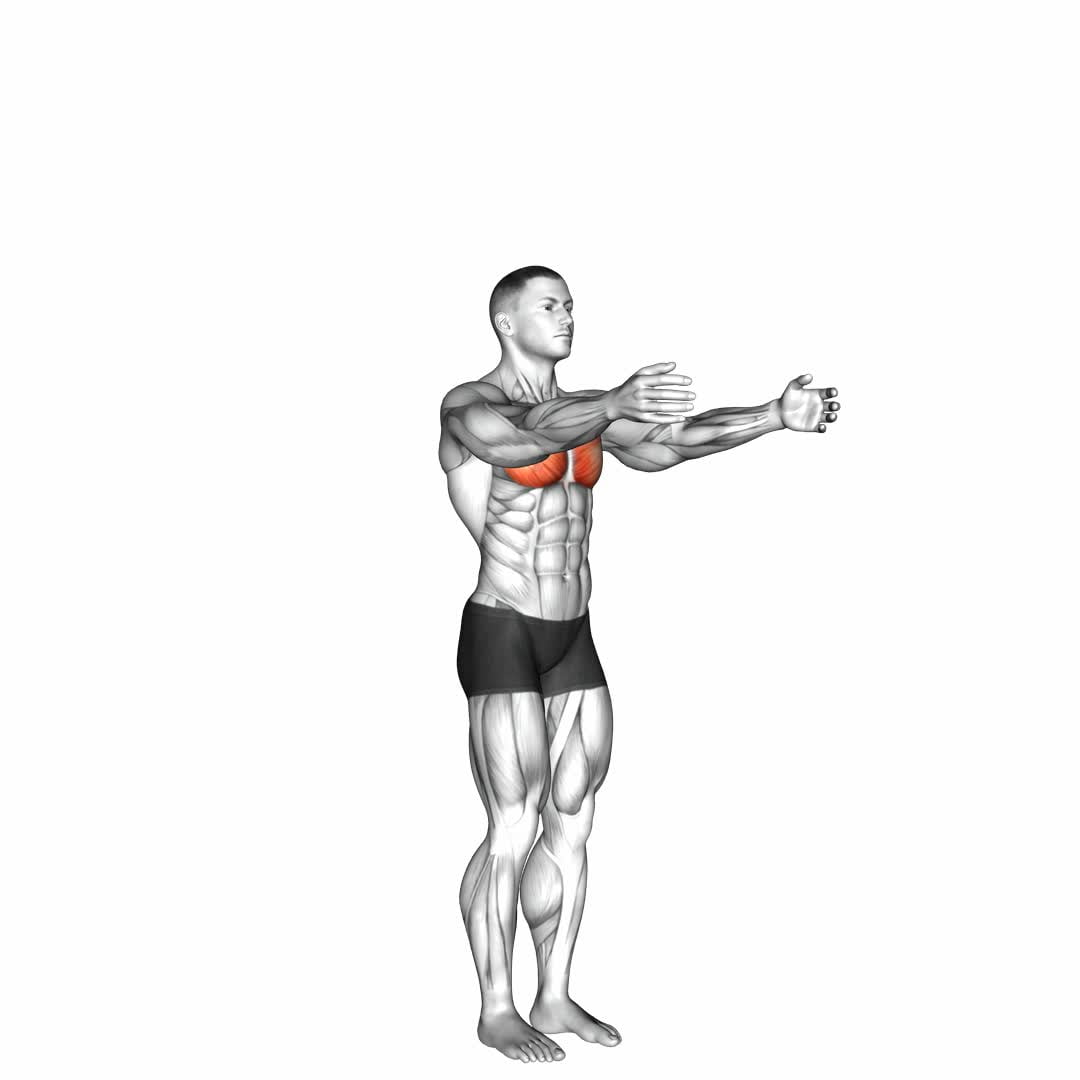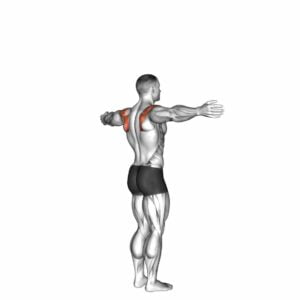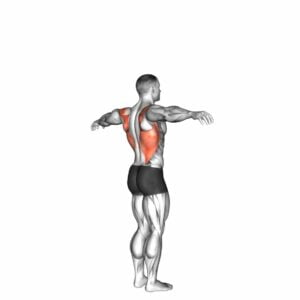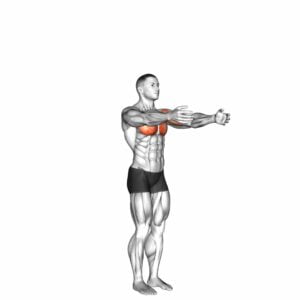Shoulder – Transverse Adduction – Video Exercise Guide & Tips

Looking to improve your shoulder strength and mobility? Check out our video exercise guide for Shoulder – Transverse Adduction.
Watch This Exercise Video
In this guide, we'll show you the proper form and technique for performing this exercise, as well as variations and progressions to challenge yourself.
Avoid common mistakes and get tips on how to incorporate Shoulder Transverse Adduction into your workout routine.
Get ready to take your shoulder workouts to the next level with our informative video guide.
Key Takeaways
- Strengthening the muscles involved in shoulder transverse adduction improves the stability of the shoulder joint.
- Shoulder transverse adduction helps reduce the risk of common shoulder injuries such as rotator cuff tears and dislocations.
- Engaging the muscles in the chest, shoulders, and upper back through shoulder transverse adduction improves their strength and endurance.
- Incorporating shoulder transverse adduction into your routine can prevent injuries and activate key muscle groups.
Benefits of Shoulder Transverse Adduction
Experience the numerous benefits of shoulder transverse adduction by incorporating this exercise into your workout routine. Shoulder transverse adduction is an effective exercise that offers several advantages, including injury prevention and muscle activation.
One of the key benefits of shoulder transverse adduction is its ability to prevent injuries. By strengthening the muscles involved in this movement, such as the pectoralis major and the anterior deltoid, you can improve the stability of your shoulder joint. This increased stability can help reduce the risk of common shoulder injuries, such as rotator cuff tears and dislocations.
Additionally, shoulder transverse adduction is an excellent exercise for muscle activation. This movement targets the muscles in your chest, shoulders, and upper back, including the pectoralis major, deltoids, and rhomboids. By engaging these muscles, you can improve their strength and endurance, leading to better overall upper body function.
Incorporating shoulder transverse adduction into your workout routine can be beneficial for both injury prevention and muscle activation. Remember to start with light weights and gradually increase the resistance as your strength improves. As with any exercise, it's important to maintain proper form and listen to your body to prevent any potential injuries.
Equipment Needed for Shoulder Transverse Adduction Exercises
To properly perform shoulder transverse adduction exercises, you'll frequently need the following equipment.
One common piece of equipment used for shoulder transverse adduction exercises is resistance bands. These bands come in various levels of resistance, allowing you to adjust the intensity of your workout. They're lightweight, portable, and versatile, making them a convenient choice for at-home or on-the-go workouts.
Another equipment option is dumbbells or weights. These can be used to add resistance to your shoulder transverse adduction exercises, making them more challenging. Start with lighter weights and gradually increase as you build strength and proficiency.
If you have access to a cable machine or a resistance machine, you can use the cables or handles to perform shoulder transverse adduction exercises. This equipment provides a smooth and controlled range of motion, allowing you to target the muscles effectively.
Remember to always choose the equipment that suits your fitness level and goals. As you become more experienced and stronger, you can explore different exercise options and equipment to continue challenging yourself and progressing in your shoulder transverse adduction workouts.
Proper Form and Technique for Shoulder Transverse Adduction
To perform shoulder transverse adduction exercises with proper form and technique, follow these steps:
- Position your body in a stable and balanced stance. Stand tall with your feet shoulder-width apart and your knees slightly bent. Keep your core engaged and your shoulders relaxed.
- Hold a resistance band or cable handle with one hand. Position your arm across your body at chest level. Your elbow should be slightly bent, and your palm facing down. This is the starting position.
- Initiate the movement by pulling your arm across your body towards the opposite side, keeping it at chest level. Focus on engaging the muscles of your chest and shoulder as you perform the adduction. Avoid using momentum or excessively swinging your arm.
- Maintain control throughout the movement and return to the starting position in a slow and controlled manner.
- Repeat for the recommended number of repetitions, and then switch sides to work the other shoulder.
Variations and Progressions of Shoulder Transverse Adduction
Now that you have mastered the proper form and technique for shoulder transverse adduction, it's time to explore the various options for exercises.
There are different exercise variations available to target your shoulder muscles from different angles, allowing for a more well-rounded workout.
As you progress in your training, you can also increase the difficulty level by adding resistance or performing the exercises on unstable surfaces.
These variations and progressions not only keep your workouts challenging but also help to enhance your shoulder strength, stability, and overall performance.
Different Exercise Options
You can try out different exercise variations and progressions to target shoulder transverse adduction. These exercise modifications allow you to challenge and strengthen the specific muscle groups involved in this movement.
One option is the standing cable chest press. By positioning the cable at shoulder height and standing with your feet shoulder-width apart, you can perform a pressing motion across your body, engaging the pectoralis major and other chest muscles.
Another option is the standing resistance band fly. Attach a resistance band to a stable object and stand with your arms extended in front of you. Slowly bring your arms out to the sides, keeping them at shoulder height, to target the muscles responsible for shoulder transverse adduction.
These exercise variations provide a range of options to effectively work the desired muscle groups.
Increasing Difficulty Levels
If you want to increase the difficulty levels of shoulder transverse adduction exercises, try incorporating more challenging variations and progressions into your routine. This will help you to continue challenging your muscles and increasing the intensity of your workouts.
One way to modify exercises is by using resistance bands or weights. By adding resistance, you're forcing your muscles to work harder and adapt to the increased load.
Another option is to perform the exercises on an unstable surface, such as a stability ball or a Bosu ball. This will engage your core muscles and require more stability and control.
Additionally, you can increase the number of repetitions or sets you do, or decrease the rest time between sets, to further challenge your muscles.
By incorporating these modifications, you can take your shoulder transverse adduction exercises to the next level and continue progressing in your fitness journey.
Transition Sentence: Now that you know how to increase the difficulty levels of shoulder transverse adduction exercises, let's explore the benefits of incorporating variations into your routine.
Benefits of Variations
To maximize the effectiveness of your shoulder transverse adduction exercises, it's important to understand the benefits that come with incorporating variations and progressions into your routine.
Variations of the shoulder transverse adduction exercise allow you to target different muscles and challenge your body in new ways. By changing the angle of your arms, the resistance used, or the range of motion, you can engage different muscle fibers and promote balanced muscle development. This not only helps prevent muscle imbalances but also enhances overall shoulder stability and functionality.
Additionally, incorporating variations and progressions into your routine can prevent boredom and keep your workouts interesting and challenging. By continuously challenging your muscles with new movements, you can promote continuous improvement and avoid plateaus.
Now, let's move on to discussing the common mistakes to avoid during shoulder transverse adduction exercises.
Common Mistakes to Avoid During Shoulder Transverse Adduction
When performing shoulder transverse adduction, it's crucial to maintain proper form to avoid injury and maximize effectiveness.
Be mindful of avoiding excessive weight, as this can put unnecessary strain on your shoulders and increase the risk of injury.
Additionally, focus on maintaining a controlled and mindful range of motion to ensure that you're targeting the correct muscles and getting the most out of your exercise.
Proper Form Importance
Maintain proper form to maximize the effectiveness and safety of your shoulder transverse adduction exercise. Proper form is essential to ensure that you're targeting the correct muscles and avoiding unnecessary strain on your joints.
By maintaining proper form, you can reap the benefits of this exercise, which include strengthening your chest, shoulders, and upper back. It also helps to improve your posture and enhance your overall upper body strength.
One common mistake to avoid is using excessive momentum or swinging your arms during the exercise. This can decrease the effectiveness of the movement and increase the risk of injury.
Another mistake to avoid is allowing your shoulders to roll forward or hunching your back, as this can put excessive stress on your neck and shoulders. Remember to keep your core engaged and maintain a stable posture throughout the exercise for optimal results.
Avoiding Excessive Weight
To avoid excessive weight and prevent potential injury during shoulder transverse adduction exercises, you should focus on using proper form and not overloading the muscles.
One of the most important aspects of avoiding injuries is to ensure that you warm up properly before starting your workout. This can be achieved through dynamic stretching exercises that target the muscles involved in shoulder transverse adduction. By warming up, you increase blood flow to the muscles, improve flexibility, and reduce the risk of strains or tears.
Additionally, it's crucial to choose an appropriate weight that challenges you without putting excessive strain on your joints and muscles. Pushing yourself too hard can lead to overuse injuries and compromise your form. Remember, safety should always be your top priority during any exercise routine.
Now, let's delve into the next section and explore the concept of mindful range of motion.
Mindful Range of Motion
Ensure proper execution of shoulder transverse adduction exercises by maintaining mindfulness of your range of motion. Mindfulness is a valuable technique that can help you avoid common mistakes and maximize the benefits of your workout.
When performing shoulder transverse adduction exercises, it's crucial to be aware of your joint mobility and avoid overextending or straining your muscles.
Mindfulness involves paying close attention to your body and being present in the moment. By practicing this technique, you can ensure that you're moving within a safe and effective range of motion.
Additionally, incorporating joint mobility exercises into your routine can help improve your overall shoulder mobility, allowing for better execution of the transverse adduction movement.
Remember to always listen to your body and adjust the intensity and range of motion accordingly.
Tips for Incorporating Shoulder Transverse Adduction Into Your Workout Routine
To effectively incorporate shoulder transverse adduction into your workout routine, start by performing this exercise in a controlled manner. This will ensure that you engage the target muscles effectively and minimize the risk of injury.
Additionally, consider making exercise modifications to suit your current fitness level and any specific limitations you may have.
One exercise modification you can try is using resistance bands or cables instead of free weights. This allows for a more controlled and stable movement, especially if you're a beginner or have shoulder stability issues. By anchoring the band or cable at a low point and pulling it across your body, you can still engage the muscles involved in shoulder transverse adduction without putting excessive strain on your joints.
Another tip is to include shoulder stability exercises in your routine. Strengthening the muscles that support your shoulder joint can improve your overall shoulder stability, making it easier to perform exercises like shoulder transverse adduction. Some examples of shoulder stability exercises include shoulder external rotations, shoulder scapular retractions, and shoulder plank variations.
Remember to always listen to your body and consult with a fitness professional if you have any concerns or questions about incorporating shoulder transverse adduction into your workout routine.
Frequently Asked Questions
How Often Should I Perform Shoulder Transverse Adduction Exercises?
To maximize the benefits of shoulder transverse adduction exercises, it's recommended that you perform them regularly. By incorporating different variations of this exercise into your routine, you can target different muscles and improve overall shoulder strength and stability.
However, the frequency of performing these exercises will depend on your fitness level and goals. It's advisable to consult with a fitness professional to determine the appropriate frequency and intensity for your specific needs.
Are There Any Modifications for Shoulder Transverse Adduction Exercises for Individuals With Shoulder Injuries?
If you have a shoulder injury, there are modifications you can make to shoulder transverse adduction exercises. These modifications help protect your injured shoulder while still working on strengthening it.
By using lighter weights or resistance bands, you can reduce the strain on your shoulder. Additionally, you can adjust your range of motion to avoid any pain or discomfort.
It's important to consult with a healthcare professional or physical therapist for specific modifications tailored to your injury.
Can Shoulder Transverse Adduction Exercises Help With Improving Posture?
Shoulder transverse adduction exercises can have a positive impact on your posture. By engaging the muscles responsible for transverse adduction, such as the pectoralis major and minor, you can improve your core stability.
These exercises help to strengthen the muscles around the shoulder joint, promoting better alignment and reducing the risk of postural imbalances.
Additionally, shoulder transverse adduction exercises can enhance shoulder mobility, allowing for a greater range of motion and improved overall movement quality.
What Muscles Are Targeted During Shoulder Transverse Adduction Exercises?
During shoulder transverse adduction exercises, several muscles are targeted. The primary muscle group engaged is the pectoralis major, which is responsible for bringing your arm across your body.
Additionally, the anterior deltoid and the coracobrachialis muscles contribute to the movement. These exercises can help strengthen and tone these muscles, leading to improved upper body strength and stability.
The benefits of shoulder transverse adduction exercises include enhanced posture, increased shoulder mobility, and improved overall upper body function.
Can Shoulder Transverse Adduction Exercises Be Beneficial for Athletes in Specific Sports?
Shoulder transverse adduction exercises can provide numerous benefits for athletes in specific sports. These exercises target the muscles responsible for shoulder adduction, such as the pectoralis major and minor, as well as the deltoids and the latissimus dorsi.
Conclusion
Incorporating shoulder transverse adduction into your workout routine can provide numerous benefits, such as improved shoulder strength and stability. By following proper form and technique, using the appropriate equipment, and avoiding common mistakes, you can maximize the effectiveness of this exercise.
Additionally, by exploring variations and progressions, you can continually challenge your muscles and prevent plateaus. Remember to consult with a professional trainer or healthcare provider before starting any new exercise program.

Author
Years ago, the spark of my life’s passion ignited in my mind the moment I stepped into the local gym for the first time. The inaugural bead of perspiration, the initial endeavor, the very first surge of endorphins, and a sense of pride that washed over me post-workout marked the beginning of my deep-seated interest in strength sports, fitness, and sports nutrition. This very curiosity blossomed rapidly into a profound fascination, propelling me to earn a Master’s degree in Physical Education from the Academy of Physical Education in Krakow, followed by a Sports Manager diploma from the Jagiellonian University. My journey of growth led me to gain more specialized qualifications, such as being a certified personal trainer with a focus on sports dietetics, a lifeguard, and an instructor for wellness and corrective gymnastics. Theoretical knowledge paired seamlessly with practical experience, reinforcing my belief that the transformation of individuals under my guidance was also a reflection of my personal growth. This belief holds true even today. Each day, I strive to push the boundaries and explore new realms. These realms gently elevate me to greater heights. The unique combination of passion for my field and the continuous quest for growth fuels my drive to break new ground.







